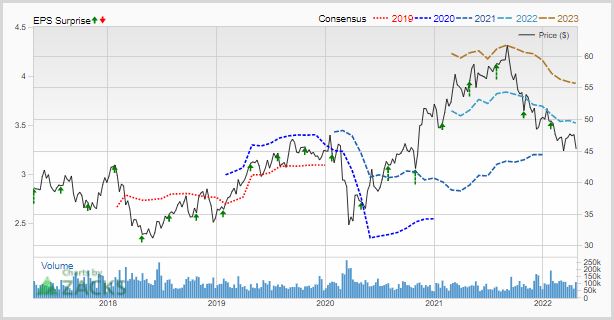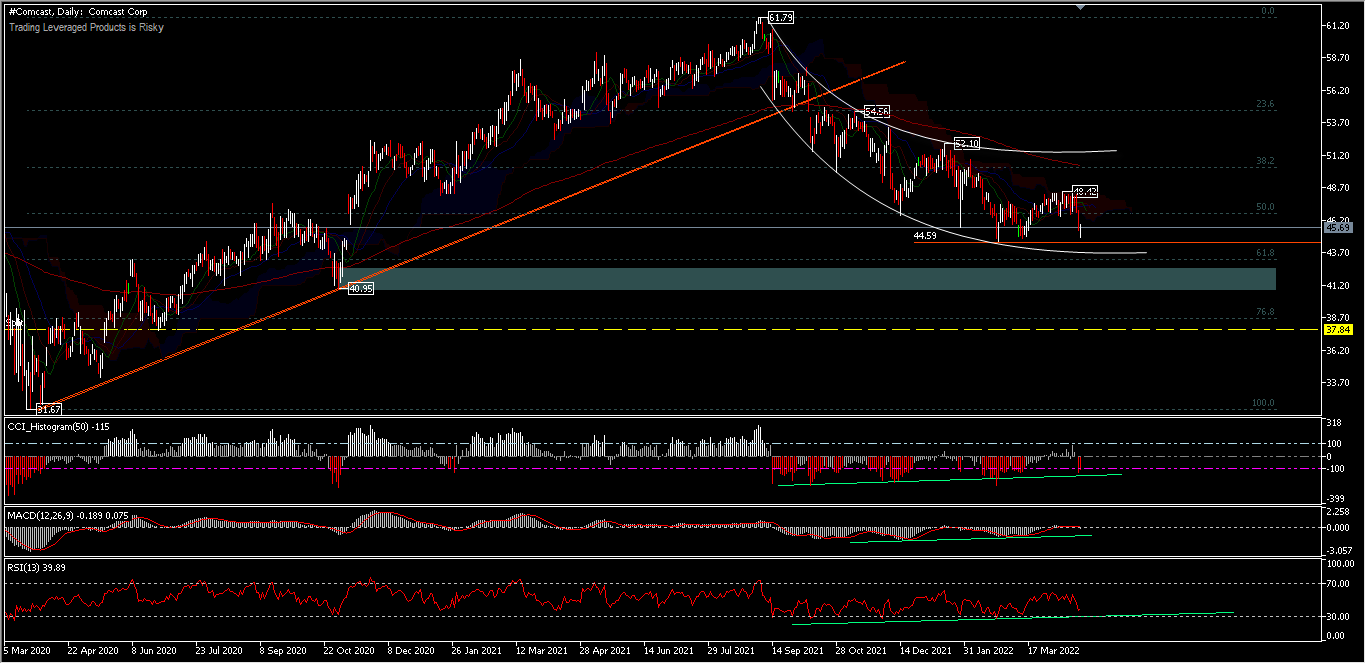This is the busiest week of the first-quarter earnings season, with a total of 165 S&P 500 companies scheduled to report their results during the first three months of 2022. Comcast will report first quarter 2022 results on April 28 along with Altria Group, Caterpillar, Eli Lilly, Gilead Sciences, Intel, Hershey, International Paper, Mastercard, McDonald’s, Merck, Northrop Grumman, Southwest Airlines, Thermo Fisher Scientific and Twitter and they will also hold conference calls to discuss earnings. The Comcast Corporation operates as a media and technology company worldwide, through the Cable Communications, Media, Studios, Theme Parks and Sky segments. The Cable Communications segment offers residential and business customers broadband, video, voice, wireless and other services under the Xfinity brand and advertising services.
Comcast’s top-line in the quarter to be reported is expected to benefit from strong growth in its broadband subscriber base and strong growth momentum in its wireless business. Wi-Fi coverage expansion and innovative xFi control features are expected to help customer growth.
Markets expect Comcast to post earnings of $0.82 per share for the first quarter of 2022. In its previous earnings report, Comcast reported earnings of $0.77/share. The Cable giant had a return on equity of 15.61% and a net margin of 12.17% on revenue of $30.34 billion for Q4 2021, compared to expectations of $29.63 billion. The increase in content consumption triggered by COVID-19 and the wave of online learning and working from home are the main drivers. On average, analysts expect Comcast to post $4 EPS for the current fiscal year.
The Zacks Consensus forecast for revenue is pegged at $30.44 billion, representing an 11.89% growth from the figure reported in last year’s quarter. The consensus figure for earnings remained at $80 /share in the last 30 days, representing a 5.26% increase from the figure reported in last year’s quarter. Share value rating is at #3 (hold). Comcast beat revenue in all of the last four quarters, and the average surprise was 18.92%.

Meanwhile, Tipranks based on 15 Wall Street analysts offered a 12-month price target for Comcast in the last 3 months. The average price target is $57.53 with an estimated high of $65.00 and an estimated low of $45.00. The average price target represents a 25.86% change from the last price of $45.71.

Based on data from MarketBeat, the company currently has an average “Buy” rating and a consensus target price of $61.44.
#Comcast, D1 – The tech-based stock dip dragged Comcast from the September 2021 peak (61.79) to around the 50.0% retracement area of the 44.59 low and the total decline reached -28%. The support at 44.59 will be a defensive level for investors, and as long as this price level holds it will bring the outlook to the upside for 48.42 first. The support of a good earnings report should increase investor interest, and the asset could test the 52.10 price level. A break of the 44.59 resistance would bring deeper correction, to 61.8% retracement level at 43.16 and 40.b95 support and in the worst case scenario a return to the February 2017 split price around 37.84 or 76.8% FR.
The Comcast price has entered the oversold zone many times as seen from the RSI and the divergence bias is clearly undeniable, with the price movement more gentle ahead of the earnings report. A break of the 44.59 resistance is needed to confirm a short term bottoming to take the asset to a more positive price. As long as the resistance holds, it could bring the sentiment to the negative side.
The company, which has a market capitalization of 204.78B as of April 25, has conducted several stock splits, the last of which occurred in February 2017. When a company like Comcast splits its shares, the market capitalization before and after the split remains stable, meaning that shareholders now own more shares, but each is priced at a lower price per share. However, lower priced stocks can attract more buyers. If the increased demand causes the stock price to appreciate, then the total market capitalization increases post-split. However, this is not always the case, often depending on the underlying business fundamentals.
Click here to access our Economic Calendar
Ady Phangestu
Market Analyst
Disclaimer: This material is provided as a general marketing communication for information purposes only and does not constitute an independent investment research. Nothing in this communication contains, or should be considered as containing, an investment advice or an investment recommendation or a solicitation for the purpose of buying or selling of any financial instrument. All information provided is gathered from reputable sources and any information containing an indication of past performance is not a guarantee or reliable indicator of future performance. Users acknowledge that any investment in Leveraged Products is characterized by a certain degree of uncertainty and that any investment of this nature involves a high level of risk for which the users are solely responsible and liable. We assume no liability for any loss arising from any investment made based on the information provided in this communication. This communication must not be reproduced or further distribution.




















